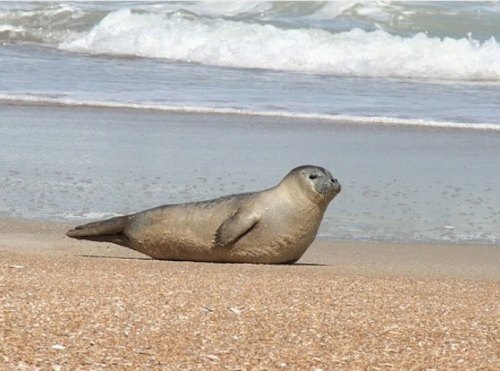Get a Seal of Approval...
It's always an exciting and rare treat to see a seal on Ocracoke, and many residents and visitors have spotted them near the NCCAT campus and at South Point over the last week. Seals are amazingly photogenic and adorable – and, well, dangerous.
We mostly see Harbor Seals on Ocracoke, which can vary in color from dark gray to tan and are often spotted. The have small heads, big eyes, and puppy-dog faces. They often rest on their sides in a banana shape. If you see a pup, it's probably about 6 – 10 months old. Harbor seals are less aggressive than other seal species and usually retreat into the water when approached, but don't count on that happening. Wild animals are unpredictable.
The Current asked NPS lead biotech Jocelyn Wright for some more information about our winter visitors. Jocelyn expressed concern that our human adoration of the seals feels like harassment to them. Here's what she had to say:
All marine mammals are protected by the Marine Mammal Protection Act (MMPA). Harassment of any marine mammal is illegal and is defined as "the potential to disturb a marine mammal or marine mammal stock in the wild by causing disruption of behavioral patterns…” The behavior pattern that we’re most likely to see on Ocracoke is seals hauling out to rest. Seals cannot maintain their body temperature if they stay in cold water all of the time because of their smaller size and thinner blubber layer so hauling out is critical. Harassment occurs when YOUR behavior changes THEIR behavior – including lifting its head to watch you.
When seals and other pinnipeds haul out, they are extremely vulnerable to human disturbance. Often they will react when humans come within 90 m (300 ft). Their reactions can be anything from a head alert – lifting their head – to flushing – retreating into the water. Even a temporary disruption can stress the animal by cutting into its time to warm up and rest. Harbor seals may also abandon a haul out site permanently, as they did at an historic site in San Francisco Bay, due to high and chronic incidences of human disturbance.

Do not attempt to feed the seals. Feeding encourages seals to approach boats looking for handouts and has resulted in injuries from boat propellers.
It’s common to observe minor injuries, cuts and abrasions. These are not cause for alarm and will heal quickly on their own. Animals that are tangled in gear – fishing line, bait bags, and plastic debris – should be reported immediately to the OBX Stranding Line (252) 455-9654.
If you still really want to approach a seal because it’s “so cute” and you want to update your social media then know this:
- Seals have several diseases that can be transmitted to humans and pets. A short list of diseases you’re exposing yourself to are: tuberculosis, herpes, conjunctivitis (pink eye), viral dermatitis , bacterial dermatitis and brucellosis (a bacterial infection).
- Seals have teeth and will not hesitate to bite you, your child, or your pet.
Seeing the seals around Ocracoke can be a magical event. They are beautiful animals that we don’t see very often. But they are wild, they are protected, and they’re trying to rest. Limit your viewing time and enjoy them from a minimum distance of 50 yards (150 feet).
Other resources:
Marine Mammal Protection Act. http://www.nmfs.noaa.gov/pr/laws/mmpa/
International fund for animal welfare. FAQs about seals. http://www.ifaw.org/united-states/our-work/animal-rescue/faqs-about-seals
Harbor Seals. Point Reyes National Seashore. http://www.nps.gov/pore/learn/nature/harbor_seals.htm




